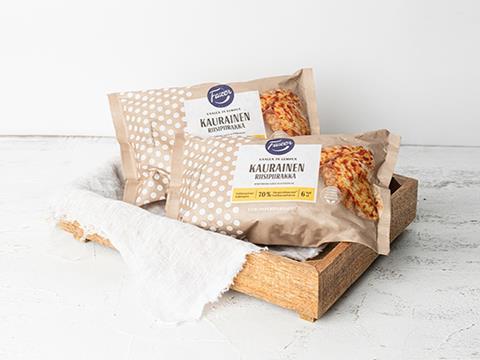
Fazer has adopted a laminate-free paper pack for its Oat Rice Pies product; the solution was designed by UPM Specialty Papers to enhance recyclability while maintaining the barrier protection and heat seal properties of conventional plastics.
Traditionally, protective properties in food packaging stem from an all-plastic design or paper packaging laminated with plastic. In both cases, the presence of plastic has allowed for heat sealing to take place.
UPM Specialty Papers has reportedly unlocked a plastic-free alternative without sacrificing the barrier and heat seal properties of a conventional pack. Based on the heat-sealable UPM Confidio barrier paper, the new paper pack is designed to preserve the product until its best-before date while keeping out grease and other contaminants.
Recyclability tests have apparently demonstrated an approximate rejection rate of around 1% for unprinted UPM Confidio paper, in which case around 99% of the paper can be recycled into new products. The recycling reject rate of plastic-coated paper packaging is said to be ‘significantly higher’.
Fazer Oat Rice Pie’s new packaging falls in line with the company’s Sustainable Packaging Vision. This involves promoting recyclable, reusable, and renewable packaging materials; cutting down on material usage without sacrificing product quality; developing new packaging with the environment in mind; and selecting the right materials to minimize food waste.
Similarly, UPM’s Biofore strategy envisions ‘a future beyond fossils’, taking such steps as replacing fossils with biomaterials and pursuing renewable solutions – targets that the new rice pie packaging is designed to complement.
“We are working closely with the packaging value chain to achieve Fazer’s responsible packaging goals,” comments Piia Soininen-Tengvall, director of Packaging Development at Fazer. “Each partner brings valuable expertise to the development work.
“This project combined Fazer’s expertise in food production and the production process while also ensuring food safety, with UPM Specialty Papers’ expertise in developing demanding specialty papers.
“We are impressed with how well the new, easier-to-recycle packaging protects and preserves the high quality of the Oat Rice Pies until the best-before date. The packaging solution works on our existing packaging process and achieves all this by reducing fossil-based materials.”
“Packaging papers have the advantage of being recyclable within a widely established fibre recycling infrastructure,” adds Susanna Hyrkäs, senior manager of Sustainability at UPM Specialty Papers. “Today, more than 80 percent of the fibre-based packaging material used in Europe is recycled.
“Our product development is always based on the premise of ensuring recyclability, in addition to ensuring product safety and the required functional properties.”
After two years of long-term development work, the pack has received WorldStar, ScanStar, and New Wood awards and is available to buy at Finnish supermarkets.
Earlier this year, Upfield took a similar step in pursuit of fibre-based packaging alternatives; it worked with Footprint, MCC, Pagès Group, and Emsur to package its plant-based butters and spreads in what claims to be an oil-resistant, plastic-free paper tub.
We spoke to packaging development director Karina Cerdeira to learn more about the development, and where the company expects it to go.
Meanwhile, ProAmpac aims for recyclability, efficiency, and consumer appeal in food packaging with its 90% fibre-based, high-barrier thermoforming solution, which has just launched on the European market.
If you liked this story, you might also enjoy:
The Brief: How viable is biorecycling for plastics?
Report: How the top brands are progressing on packaging sustainability
The Brief: Using ocean-bound plastic in packaging – how, why and should we?




















No comments yet